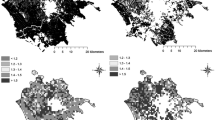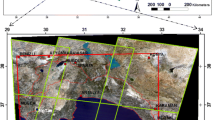Abstract
Land degradation is a process negatively affecting environmental sustainability and requires permanent monitoring for understanding its nonlinear trajectories of change over time and space. Environmental sustainability is linked to a theoretical definition of dynamic balance among various components contributing to the ecosystem quality and functioning. The aim of this study is to develop a diachronic analysis (1960–2010) of the equilibrium/disequilibrium condition of key environmental factors (climate, soil, vegetation, land-use) influencing the vulnerability of land to degradation in a Mediterranean country experiencing processes of desertification at the local scale. Three indicators of components’ balance have been proposed and tested for spatial and temporal coherence. Land classified at high vulnerability and low component’s balance has been identified as a possible target for mitigation strategies against desertification; the surface area of this class increased rapidly during 1960–2010 and concentrated in high-intensity agricultural lowlands of northern Italy.





Similar content being viewed by others
References
Arrow, K., Bolin, B., Costanza, R., Dasgupta, P., Folke, C., Holling, C. S., et al. (1995). Economic growth, carrying capacity, and the environment. Science, 268, 520–521.
Basso, F., Bove, E., Dumontet, S., Ferrara, A., Pisante, M., Quaranta, G., et al. (2000). Evaluating environmental sensitivity at the basin scale through the use of geographic information systems and remotely sensed data: An example covering the Agri basin—Southern Italy. Catena, 40, 19–35.
Böhringer, C., & Jochem, P. E. P. (2007). Measuring the immeasurable—a survey of sustainability indices. Ecological Economics, 63(1), 1–8.
Boyce, J. K. (1994). Inequality as a cause of environmental degradation. Ecological Economics, 11, 169–178.
Brandt, J. (2005). Desertification information system to support National Action Programmes in the Mediterranean (DISMED). DIS4ME, Desertification Indicator System for Mediterranean Europe (www.unibas.it/desertnet/dis4me/using_dis4me/dismed.htm accessed Nov 2012).
Casadio-Tarabusi, E., & Palazzi, P. (2004). An index for sustainable development. BNL Quarterly Review, 299, 185–206.
Chakravarty, S. R. (2003). A generalized human development index. Review of Development Economics, 7(1), 99–114.
Daly, H. E. (1990). Toward some operational principles of sustainable development. Ecological Economics, 2, 1–6.
Ekins, P. (2002). Economic growth and environmental sustainability. The prospective for green growth. London: Routledge.
Feoli, E., Giacomich, P., Mignozzi, K., Oztürk, M., & Scimone, M. (2003). Monitoring desertification risk with an index integrating climatic and remotely-sensed data: An example from the coastal area of Turkey. Management of the Environmental Quality, 14, 10–21.
Ferrara, A., Salvati, L., Sateriano, A., & Nolè, A. (2012). Performance evaluation and costs assessment of a key indicator system to monitor desertification vulnerability. Ecological Indicators, 23, 123–129.
Galeotti, M. (2007). Economic growth and the quality of the environment: Taking stock. Environment, Development and Sustainability, 9, 427–454.
Gisladottir, G., & Stocking, M. (2005). Land degradation control and its global environmental benefits. Land Degradation and Development, 16, 99–112.
Goodland, R. (1995). The concept of environmental sustainability. Annual Review of Ecology and Systematics, 26, 1–24.
Goodland, R., & Daly, H. (1996). Environmental sustainability: Universal and non-negotiable. Ecological Applications, 6(4), 1002–1017.
Hamdouch, A., & Zuindeau, B. (2010). Sustainable development, 20 years on: Methodological innovations, practices and open issues. Journal of Environmental Planning and Management, 53(4), 427–438.
Herrmann, S. M., & Hutchinson, C. F. (2005). The changing contexts of the desertification debate. Journal of Arid Environment, 63, 538–555.
Ibanez, J., Martinez Valderrama, J., & Puigdefabregas, J. (2008). Assessing desertification risk using system stability condition analysis. Ecological Modelling, 213, 180–190.
ISTAT. (2006). Atlante statistico dei comuni. Roma: Istituto Nazionale di Statistica.
Kosmas, C., Danalatos, N. G., & Gerontidis, S. (2000a). The effect of land parameters on vegetation performance and degree of erosion under Mediterranean conditions. Catena, 40, 3–17.
Kosmas, C., Gerontidis, S., & Marathianou, M. (2000b). The effect of land use change on soil and vegetation over various lithological formations on Lesvos. Catena, 40, 51–68.
Kosmas, C., Kirkby, M., & Geeson, N. (1999). Manual on key indicators of desertification and mapping environmental sensitive areas to desertification. European Commission, Directorate General, Project ENV4 CT 95 0119, EUR 18882, Bruxelles (http://www.kcl.ac.uk/projects/desertlinks/downloads/publicdownloads/ESA%20Manual.pdf visited in Oct 2009).
Lavado Contador, J. F., Schnabel, S., Gomez Gutierrez, A., & Pulido Fernandez, M. (2009). Mapping sensitivity to land degradation in Extremadura, SW Spain. Land Degradation and Development, 20(2), 129–144.
Lawn, P. A. (2003). A theoretical foundation to support the Index of Sustainable Economic Welfare (ISEW), Genuine Progress Indicator (GPI), and other related indexes. Ecological Economics, 44(1), 105–118.
Malkina-Pykh, I. G., & Pykh, Y. A. (2008). Quality-of-life indicators at different scales: Theoretical background. Ecological Indicators, 8(6), 854–862.
McMichael, A. J., Butler, C. D., & Folke, C. (2003). New visions for addressing sustainability. Science, 302(5652), 1919–1920.
Montanarella, L. (2007). Trends in land degradation in Europe. In M. V. Sivakumar & N. N’diangui (Eds.), Climate and land degradation. Berlin: Springer.
Moonen, A. C., Ercoli, L., Mariotti, M., & Masoni, A. (2002). Climate change in Italy indicated by agrometeorological indices over 122 years. Agricultural and Forest Meteorology, 111, 13–27.
Myers, G., & Macnaghten, P. (1998). Rhetorics of environmental sustainability: Commonplaces and places. Environment and Planning A, 30, 333–354.
Nader, M. R., Salloum, B. A., & Karam, N. (2008). Environment and sustainable development indicators in Lebanon: A practical municipal level approach. Ecological Indicators, 8(5), 771–777.
Niemeijer, D. (2002). Developing indicators for environmental policy: Data-driven and theory-driven approaches examined by example. Environmental Science & Policy, 5(2), 91–103.
Nourry, M. (2008). Measuring sustainable development: Some empirical evidence for France from eight alternative indicators. Ecological Economics, 67(3), 441–456.
Salvati, L., & Bajocco, S. (2011). Land sensitivity to desertification across Italy: Past, present, and future. Applied Geography, 31(1), 223–231.
Salvati, L., Perini, L., Ceccarelli, T., Zitti, M., & Bajocco, S. (2011). Towards a process-based evaluation of land vulnerability to degradation: A spatio-temporal approach in Italy. Ecological Indicators, 11(5), 1216–1227.
Salvati, L., & Zitti, M. (2008). Regional convergence of environmental variables: Empirical evidences from land degradation. Ecological Economics, 68, 162–168.
Salvati, L., & Zitti, M. (2009). Assessing the impact of ecological and economic factors on land degradation vulnerability through multiway analysis. Ecological Indicators, 9, 357–363.
Sands, G. R., & Podmore, T. H. (2000). A generalized environmental sustainability index for agricultural systems. Agriculture, Ecosystems & Environment, 79(1), 29–41.
Siche, J. R., Agostinho, F., Ortega, E., & Romeiro, A. (2008). Sustainability of nations by indices: Comparative study between environmental sustainability index, ecological footprint and the energy performance indices. Ecological Economics, 66(4), 628–637.
Simeonakis, E., Calvo-Cases, A., & Arnau-Rosalen, E. (2007). Land use change and land degradation in southeastern Mediterranean Spain. Environmental Management, 40, 80–94.
Sivakumar, M. V. K. (2007). Interactions between climate and desertification. Agricultural and Forest Meteorology, 142, 143–155.
Steer, A. (1998). Making development sustainable. Advances in Geo-Ecology, 31, 857–865.
Thornes, J. B. (2004). Stability and instability in the management of Mediterranean desertification. In J. Wainwright & M. Mulligan (Eds.), Environmental modelling: Finding simplicity in complexity (pp. 303–315). Chichester: Wiley.
Zuindeau, B. (2006). Spatial approach to sustainable development: Challenges of equity and efficacy. Regional Studies, 40(5), 459–470.
Zuindeau, B. (2007). Territorial Equity and Sustainable Development. Environmental Values, 16(2), 253–268.
Author information
Authors and Affiliations
Corresponding author
Rights and permissions
About this article
Cite this article
Salvati, L. Toward a ‘Sustainable’ land degradation? Vulnerability degree and component balance in a rapidly changing environment. Environ Dev Sustain 16, 239–254 (2014). https://doi.org/10.1007/s10668-013-9463-z
Received:
Accepted:
Published:
Issue Date:
DOI: https://doi.org/10.1007/s10668-013-9463-z




